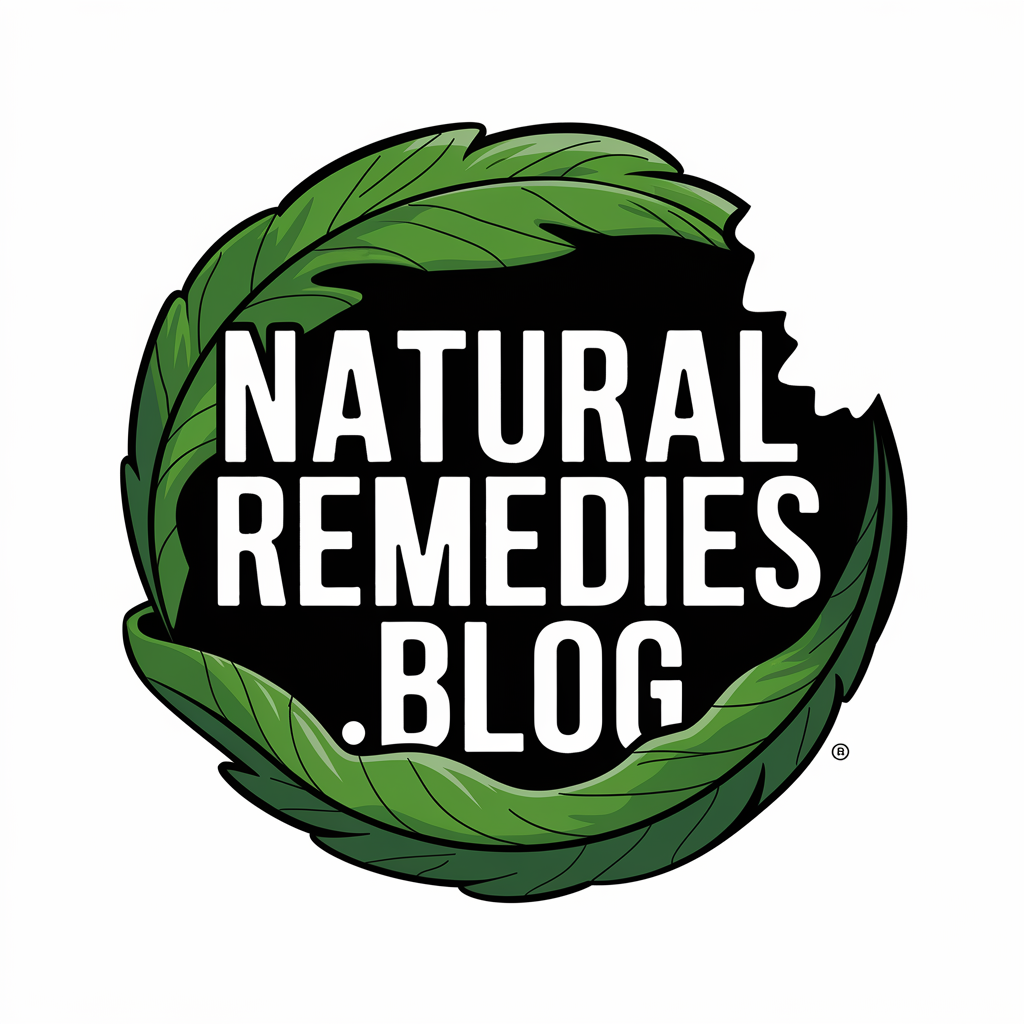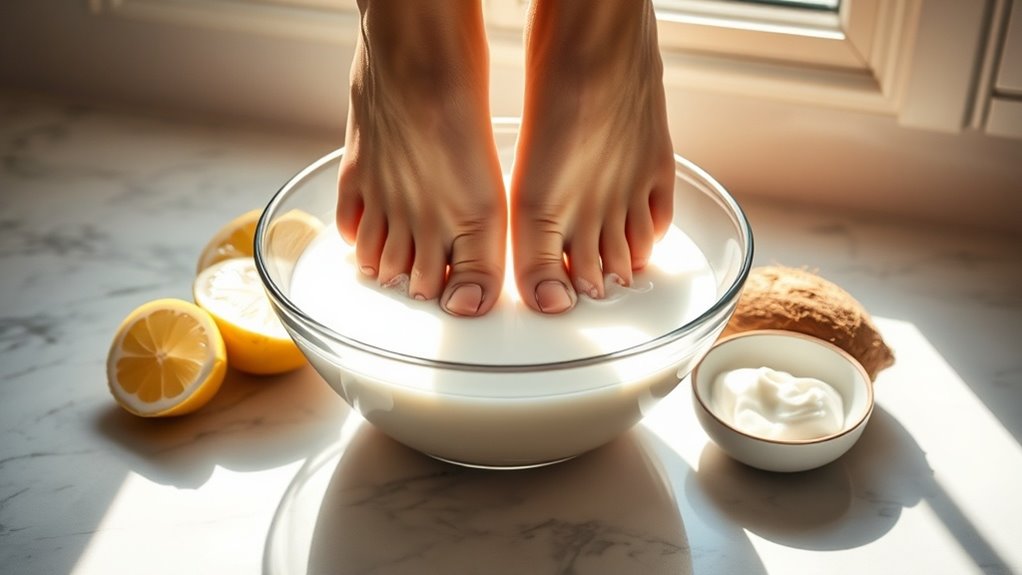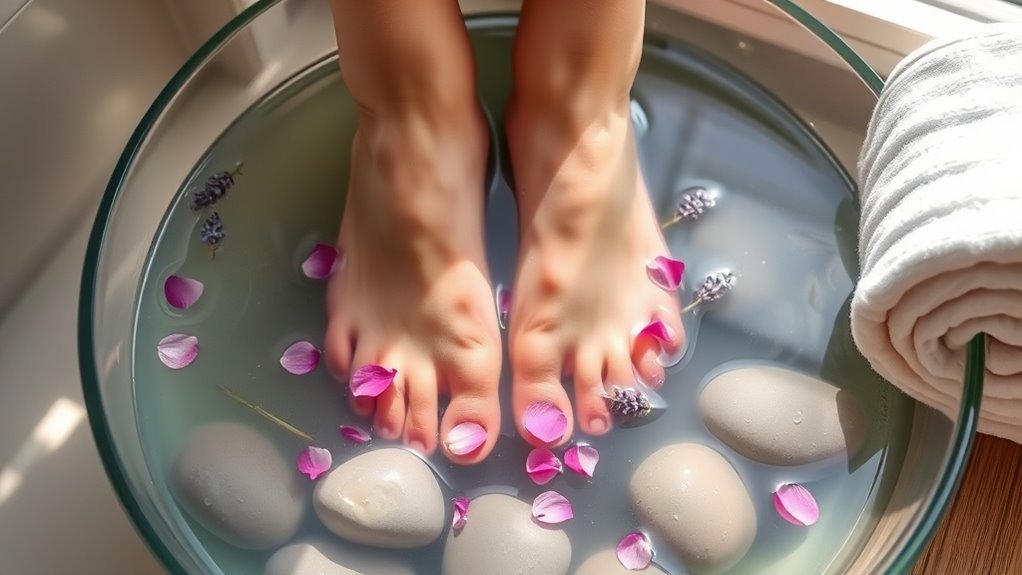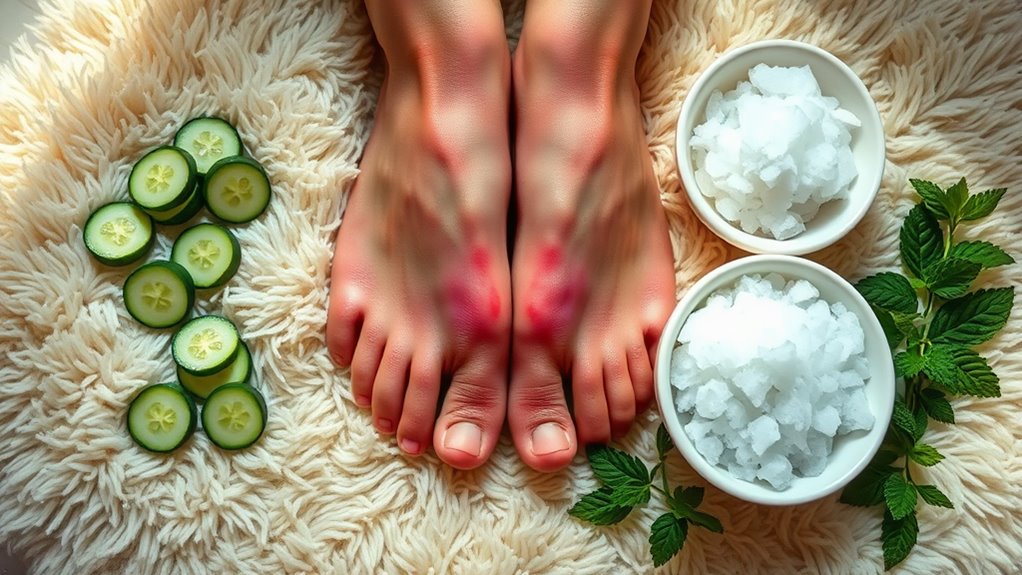This Natural Foot Remedy Totally Changed My Routine
You’ll revolutionize your foot care routine with tea tree oil’s potent terpinen-4-ol compound, which penetrates the stratum corneum to combat plantar fasciitis and hyperhidrosis. When combined with natural butters and botanical extracts, this evidence-based solution activates mechanoreceptors while stimulating lymphatic drainage. The antimicrobial properties enhance peripheral circulation and neurotransmitter production, offering superior results to traditional NSAIDs and orthotics. Discover how this ancient Aboriginal remedy transforms foot biomechanics and overall wellness.
My Struggle With Foot Discomfort
While many foot conditions manifest gradually, my experience with plantar fasciitis emerged suddenly during my medical residency. The intense heel pain radiated through my plantar fascia, making each step excruciating.
Standing for 12-hour shifts exacerbated the inflammation of my medial calcaneal tubercle. You’ll understand the desperation when conventional foot remedies fail to provide relief.
The pain disrupted my gait biomechanics, leading to compensatory mechanisms that affected my entire kinetic chain. Traditional NSAIDs and orthotic interventions offered minimal improvement, forcing me to seek alternative therapeutic approaches for this debilitating musculoskeletal condition.
I discovered that essential oils in Listerine can effectively penetrate the skin to reduce inflammation and provide much-needed relief.
Discovering the Ancient Tea Tree Solution
After exhausting conventional treatments, I discovered tea tree oil’s therapeutic potential through ancient Aboriginal medicine. The Melaleuca alternifolia extract’s antimicrobial properties revolutionized my approach to managing pedal dermatological conditions.
-
Terpinen-4-ol, the active compound, penetrates deeply into the stratum corneum, eliminating fungal pathogens.
-
The oil’s natural antiseptic properties create an inhospitable environment for dermatophytes.
-
Clinical studies demonstrate significant reduction in plantar hyperhidrosis and malodor.
-
Traditional application methods involve diluting 10 drops in a carrier oil for optimal dermal absorption.
The ancient remedy’s efficacy in treating various podiatric conditions stems from its unique molecular composition and broad-spectrum antimicrobial activity.
Key Ingredients and Their Benefits
Your therapeutic journey into natural foot care incorporates potent essential oils, including Melaleuca alternifolia and Lavandula angustifolia, which deliver antimicrobial and anti-inflammatory properties directly to the plantar epidermis.
Natural butters, particularly those derived from Butyrospermum parkii and Theobroma cacao, create an occlusive barrier while facilitating deep dermal penetration of active botanicals.
The synergistic combination of these ingredients with botanical extracts such as Calendula officinalis and Aloe barbadensis miller promotes cellular regeneration and enhances the stratum corneum’s natural moisture retention capabilities.
The addition of medium-chain fatty acids found in coconut oil provides deep moisturization while creating a protective barrier against environmental damage.
Essential Oils for Relief
Essential oils provide therapeutic benefits for various podiatric conditions through their anti-inflammatory, analgesic, and antimicrobial properties. When you’re experiencing plantar fasciitis, metatarsalgia, or peripheral neuropathy, specific essential oils can target these conditions effectively.
-
Tea tree oil’s antimicrobial compounds combat fungal infections and neutralize odor-causing bacteria.
-
Eucalyptus oil penetrates deep into the plantar fascia, reducing inflammation and providing rapid pain relief.
-
Peppermint oil’s menthol content creates vasodilation, improving circulation and reducing muscle tension.
-
Lavender oil’s anti-inflammatory properties help decrease edema while promoting tissue regeneration and healing.
Natural Butters and Botanicals
Combining the therapeutic power of natural butters and botanicals with topical foot care creates a comprehensive healing approach.
Shea butter’s rich concentration of vitamins A, E, and F penetrates deep into the epidermal layer, promoting cellular regeneration and collagen synthesis. Cocoa butter’s antioxidant properties combat free radicals while forming a protective barrier against transepidermal water loss.
Botanical extracts like calendula and chamomile deliver anti-inflammatory compounds directly to plantar tissues.
You’ll find arnica’s sesquiterpene lactones particularly effective for reducing edema and muscle soreness. Comfrey root’s allantoin accelerates the healing of minor abrasions and calluses while stimulating new skin cell formation.
Step-by-Step Application Guide
Looking to achieve optimal therapeutic results from this natural foot remedy? Follow this precise protocol to maximize absorption through the plantar epidermis and enhance therapeutic efficacy.
-
Begin with thorough cleansing using lukewarm water and antimicrobial cleanser, focusing on interdigital spaces.
-
Apply remedy using firm circular motions, targeting the plantar fascia and metatarsal heads.
-
Wrap feet in organic cotton compress for 20 minutes to enhance transdermal penetration.
-
Conclude with gentle lymphatic drainage strokes from distal to proximal regions.
This clinical approach ensures maximum bioavailability of active botanicals while promoting circulation throughout the pedal structures.
For additional comfort during treatment, create a soothing atmosphere with playful breathing exercises to promote relaxation and healing.
Morning Vs Evening Treatment Results
After mastering the application protocol, timing your treatment can significantly impact therapeutic outcomes.
Morning applications optimize circulation when your plantar fascia is most rigid, reducing post-sleep inflammation and enhancing mobility throughout the day. You’ll experience peak absorption during a.m. hours due to lower cortisol levels.
Evening treatments, however, capitalize on your body’s natural healing cycle during sleep. Your peripheral blood flow increases by 20% at night, maximizing the remedy’s therapeutic compounds.
Additionally, reduced mechanical stress during rest allows deeper penetration into connective tissues and interstitial spaces.
For optimal results, consider incorporating Epsom salt soaks which naturally draw out excess fluid through osmosis while providing muscle relaxation benefits.
Unexpected Benefits Beyond Foot Care
Beyond addressing plantar fasciitis and pedal discomfort, your natural foot remedy can stimulate the parasympathetic nervous system, leading to enhanced sleep quality through increased melatonin production.
You’ll experience elevated serotonin and dopamine levels, which directly influence mood regulation and emotional well-being.
The treatment’s activation of peripheral nerve endings triggers the release of endorphins, resulting in increased energy levels and improved cognitive function throughout your day.
The combination of thymol and menthol provides a refreshing sensation while naturally fighting fungal issues and bacteria.
Better Sleep Quality
While many consider natural foot remedies primarily for addressing podiatric concerns, these treatments can significantly enhance sleep quality through their effects on the body’s circadian rhythm and parasympathetic nervous system.
You’ll experience somatic responses that optimize your nocturnal rest patterns.
- Stimulation of plantar fascia receptors triggers vasodilation, reducing peripheral vascular resistance and promoting thermal regulation.
- Activation of meridian points enhances melatonin secretion from the pineal gland.
- Manipulation of reflexology zones induces autonomic nervous system modulation.
- Enhanced lymphatic circulation decreases nocturnal cortisol levels, facilitating deeper sleep phases.
These neurophysiological responses create optimal conditions for restorative sleep cycles.
Mood and Energy Boost
Although commonly associated with localized relief, natural foot treatments activate systemic neuroendocrine pathways that enhance mood regulation and cellular energy production.
You’ll experience increased serotonin and dopamine release through stimulation of plantar mechanoreceptors, triggering the hypothalamic-pituitary axis. This neurochemical cascade optimizes your circadian rhythm and ATP synthesis within mitochondria.
The enhanced neurotransmitter activity combines with improved peripheral circulation, delivering oxygen-rich blood to vital organs.
Your body’s stress response moderates through reduced cortisol levels, while beta-endorphin release creates a sustained sense of well-being and mental clarity throughout your day.
Cost Comparison With Commercial Products
Compared to commercial foot care products, natural remedies can provide significant cost savings when treating common podiatric conditions.
You’ll find that utilizing natural ingredients for plantar fasciitis, hyperkeratosis, and digital deformities offers a cost-effective alternative to expensive over-the-counter solutions.
-
A 32-ounce bottle of therapeutic-grade epsom salt ($4) treats multiple conditions vs. single-use medicated pads ($15)
-
Essential oils like tea tree and eucalyptus ($8) last 6 months vs. antifungal sprays ($20/month)
-
Natural moisturizers including coconut oil ($6) replace specialized creams ($25)
-
DIY soaking solutions ($0.50/treatment) vs. commercial foot baths ($8/treatment)
Regular Listerine foot soaks provide an affordable alternative to professional pedicures while delivering similar therapeutic benefits.
Combining the Remedy With Daily Habits
You’ll maximize therapeutic benefits by integrating your natural foot remedy into both morning and evening self-care protocols, targeting plantar tissue when it’s most receptive to treatment.
For optimal absorption during morning applications, apply the remedy post-shower when the stratum corneum exhibits increased permeability and before weight-bearing activities commence.
Evening applications prove most efficacious when combined with manual lymphatic drainage techniques and elevation of the lower extremities, allowing the remedy’s active compounds to penetrate while you’re in a non-ambulatory state.
Regular treatment with antifungal essential oils can help prevent common foot problems while maintaining skin health.
Morning Self-Care Steps
While establishing an effective foot care routine requires commitment, integrating natural remedies into your morning regimen can optimize therapeutic outcomes. The strategic application of therapeutic agents during your circadian peak enhances absorption and maximizes plantar tissue repair.
-
Begin with a 3-minute warm water soak to increase peripheral circulation and prepare the dermis for treatment.
-
Apply your natural remedy using digital pressure to stimulate lymphatic drainage.
-
Perform targeted stretches focusing on the plantar fascia and Achilles tendon.
-
Don moisture-wicking socks to maintain therapeutic contact and protect treated areas.
Evening Application Tips
Integrating therapeutic foot treatments into your evening routine leverages the body’s natural circadian rhythms for enhanced healing and repair.
During nocturnal hours, your plantar fascia and metatarsal structures experience optimal absorption of topical applications.
You’ll want to cleanse the pedal region thoroughly, paying attention to the interdigital spaces.
Apply the remedy using firm, proximal-to-distal strokes along the plantar surface. Focus on pressure points near the calcaneus and metatarsal heads.
Don elevated socks to maintain product contact throughout your sleep cycle, allowing maximum therapeutic benefit during the foot’s natural recovery phase.
Best Times for Treatment
Beyond nocturnal applications, strategic timing of foot treatments throughout your daily routine can amplify therapeutic outcomes.
Optimal timing correlates with your plantar fascia’s natural flexibility and circulatory patterns.
-
Post-shower applications maximize absorption through dilated pores and hydrated epithelial tissue
-
Mid-afternoon treatments coincide with peak ankle mobility during circadian joint function
-
Pre-exercise applications enhance proprioception and metatarsal flexibility
-
Post-activity treatments target inflammation reduction when your interstitial fluid circulation is most active
Synchronizing treatment with these physiological windows optimizes the remedy’s therapeutic efficacy and supports sustained plantar health.
Three Months of Transformation
Although structural changes to foot biomechanics occur gradually, you’ll notice significant improvements within three distinct phases over a 12-week period.
During weeks 1-4, plantar fascia inflammation subsides as intrinsic foot muscles strengthen.
By weeks 5-8, you’ll experience enhanced proprioception and arch stability, with notable improvements in metatarsal alignment.
The final phase, weeks 9-12, brings neuromuscular adaptation, resulting in optimized gait mechanics and redistributed plantar pressure patterns.
Your foot’s intrinsic musculature will have developed sufficient endurance and strength to maintain proper anatomical positioning throughout daily activities.
Tips for Long-Term Maintenance
Once your feet have achieved optimal biomechanical function through the 12-week rehabilitation period, maintaining these gains requires consistent vigilance and proper care protocols.
Your long-term foot health depends on implementing these evidence-based maintenance strategies.
- Perform daily intrinsic foot muscle exercises, focusing on toe flexion and plantar fascia activation
- Maintain proper longitudinal arch support through targeted proprioceptive training
- Monitor gait mechanics bi-weekly, ensuring neutral subtalar joint positioning
- Implement regular self-myofascial release techniques using specialized tools to address plantar tissues
These protocols will help preserve your restored foot biomechanics and prevent functional regression.







